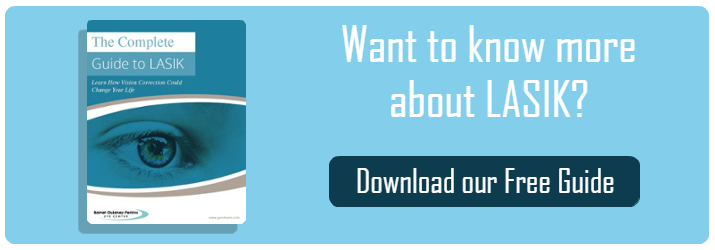
Fortunately,LASIK eye surgery usually makes it so you don’t have to make that choice anymore. If you are a good candidate for the procedure, you will receive the benefit of state-of-the-art technology designed to correct your vision and minimize risk. Lasik eye surgery can change daily routines, simply by decreasing reliance on your glasses.
What Does LASIK Surgery Do?
Laser-Assisted In Situ Keratomileusis (LASIK)is the use of lasers to reshape a person’s cornea, changing the ability to see clearly close up and far away. It is a refractive surgery that alters the way light passes through the cornea to the retina. Lasers are used to open and remove corneal tissue so the patient’s cornea resembles the shape of cornea in those with clear vision.
The procedure itself is short and brings minimal complications. Once patients have recovered fromLASIK eye surgery, they can often put away glasses or contact lenses, as they no longer need them. While aLASIK vision center cannot guarantee that patients who have the surgery will no longer need glasses, the vast majority notice that their vision is much better.
Who is a Good Candidate for LASIK?
Most adults with mild to moderate myopia (nearsighted), hyperopia (farsighted) or astigmatism could be eligible forLASIK eye surgery. These factors may affect your ability to have the surgery:
- Age – You must be at least 18
- Health – You must be in good general health
- Eye Health – Conditions such as cataracts or dry eyes may make you ineligible
- Vision Prescription – You should have a consistent prescription that doesn’t frequently change
People with chronic dry eyes are often told that they cannot have LASIK.The Review of Ophthalmology reported that LASIK has dry eye symptoms as a common, short-term side effect of the procedure. Surgeons do not want to take a patient’s painful condition and make it worse. However, the increasing popularity of LASIK means that more people are getting dry eyes identified earlier and have dry eye treatment well before the surgery.
If you are unsure whether LASIK is right for you, start by taking our self-evaluation and schedule a consultation with a doctor.
How is LASIK Eye Surgery Performed?
The procedure forLASIK eye surgery is typically short, about 10-15 minutes per eye. The surgeon starts by placing numbing drops in your eyes, and putting a low-impact suction device on the eye to prevent movement of the cornea. Surgeons may use either a YAG laser or a femtosecond laser to create an initial flap in your corneal tissue.Barnet Dulaney Perkins Eye Center uses a femtosecond laser for greater precision and a lower risk of corneal damage.
The laser creates an acoustic shock wave that disrupts some of the corneal tissue, which may then be removed. The femtosecond laser creates the flap without disrupting as much tissue, making the femtosecond laser 106 times less likely to cause collateral damage during the procedure.
The effectiveness of the procedure requires a thorough analysis of the eyes, to identify all the irregularities so that the surgeon can create a custom plan to re-shape the cornea. This is most often performed with a wavefront-guided laser that builds a map of your eye. By seeing how light passes through your eye compared to how it should pass through with 20/20 vision, the surgeon knows precisely where to remove corneal tissue.
Once the flap has been created, the surgeon takes an excimer laser to remove corneal tissue. If you are nearsighted, the surgeon will flatten your cornea somewhat. If you are farsighted, your doctor will make your cornea slightly more conical / round in shape. Surgeons correct astigmatism by shaping your irregular cornea.
The Wavelight Allegretto Wave Eye-Q femtosecond laser has the ability to remove tissue without negatively affecting the natural shape of the cornea, thus preventing vision halos or difficulty seeing at night. Once the surgeon is done removing tissue, he / she replaces the flap, removes the suction device from the eye and gives drops and protective eyewear to the patient to reduce the likelihood of injury.
How Well Does LASIK Work?
The American Academy of Ophthalmology reports that LASIK is quite effective for most people who have the procedure. However, the overall experience withLASIK eye surgery relies not just on the surgeon and the technology, but also the clinic itself. From start to finish, you need to know that your surgeon and support staff will take care of your needs expertly and professionally.
Consider patient testimonials from your chosen clinic to learn more about other patients’ experiences and whether they would recommend the surgeon to others. LASIK eye surgery can dramatically improve your vision for years to come. When you are ready to see how LASIK could change your life, ask your eye doctor for a consultation.


